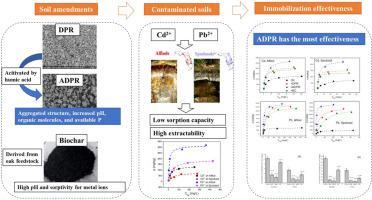Chemosphere ( IF 8.1 ) Pub Date : 2020-12-04 , DOI: 10.1016/j.chemosphere.2020.129202 Beibei Liu , Zhenli He , Ruliang Liu , Andrea C. Montenegro , Martin Ellis , Qinfen Li , Virupax C. Baligar

|
Sandy soils in Florida are vulnerable to toxic metal pollution, and it is necessary to identify desirable amendments for the remediation of metal contaminated soils. Sorption and incubation experiments were conducted to compare the effectiveness of dolomite phosphate rock (DPR), humic acid activated dolomite phosphate rock (ADPR) and biochar (BC) in immobilizing Cd2+ and Pb2+ in two representative agricultural soils in south Florida (Alfisol-Riviera and Spodosol -Ankona series). The results showed that the soils had a low sorption capacity for metals with maximum sorption of 0.767–3.30 mg/g. Application of amendments increased the maximum sorption by 4.2–4.8 times for Pb2+ and 1.5–2.2 times for Cd2+ in Alfisol soil, and 7.1–7.9 times for Pb2+ and 1.7–3.1 times for Cd2+ in Spodosol soil. ADPR was the most effective amendment for increasing the soil’s sorption capacity for Cd2+ and Pb2+. 0.01 M CaCl2 extractable metals in the contaminated soils were significantly decreased by all the amendments, especially ADPR, which reduced extractable Cd2+ and Pb2+by 87.2 and 76.0% in Alfisol and 91.3 and 76.3% in Spodosol soil as compared to control. The amounts of extractable Cd2+ and Pb2+ were negatively correlated with soil pH and available P, indicating that the change of soil characteristics by amendments was the dominant mechanism for enhanced immobilization of metals in the contaminated soils. These results indicate that ADPR has great potential for remediating toxic levels of Cd2+ and Pb2+ in contaminated soils.
中文翻译:

活化白云石磷酸盐岩和生物炭固定土壤中镉和铅的比较效果
佛罗里达州的沙质土壤易受到有毒金属污染的影响,因此有必要找出可取的修正剂,以修复金属污染的土壤。进行了吸附和孵化实验,以比较佛罗里达州南部两种代表性农业土壤中白云石磷酸盐岩(DPR),腐殖酸活化白云石磷酸盐岩(ADPR)和生物炭(BC)固定Cd 2+和Pb 2+的有效性( Alfisol-Riviera和Spodosol-Ankona系列)。结果表明,土壤对金属的吸附能力较低,最大吸附率为0.767–3.30 mg / g。修正案通过应用4.2-4.8倍增加铅的最大吸附2+和1.5-2.2倍镉2+在Alfisol土壤中,Ppo 2+的含量为Pb 2+的7.1-7.9倍,Cd 2+的含量为1.7-3.1倍。ADPR是提高土壤对Cd 2+和Pb 2+的吸附能力的最有效改良剂。通过所有修正,特别是ADPR,污染土壤中的0.01 M CaCl 2可萃取金属均显着降低,与对照相比,Alfisol中可萃取Cd 2+和Pb 2+降低了97.2%,Spodosol土壤中可萃取Cd 2+和Pb 2+降低了96.0%和76.3% 。Cd 2+和Pb 2+的提取量与土壤pH和有效磷呈负相关,表明通过修正改变土壤特性是增强土壤中金属固定化的主要机制。这些结果表明,ADPR具有修复污染土壤中Cd 2+和Pb 2+毒性水平的巨大潜力。











































 京公网安备 11010802027423号
京公网安备 11010802027423号